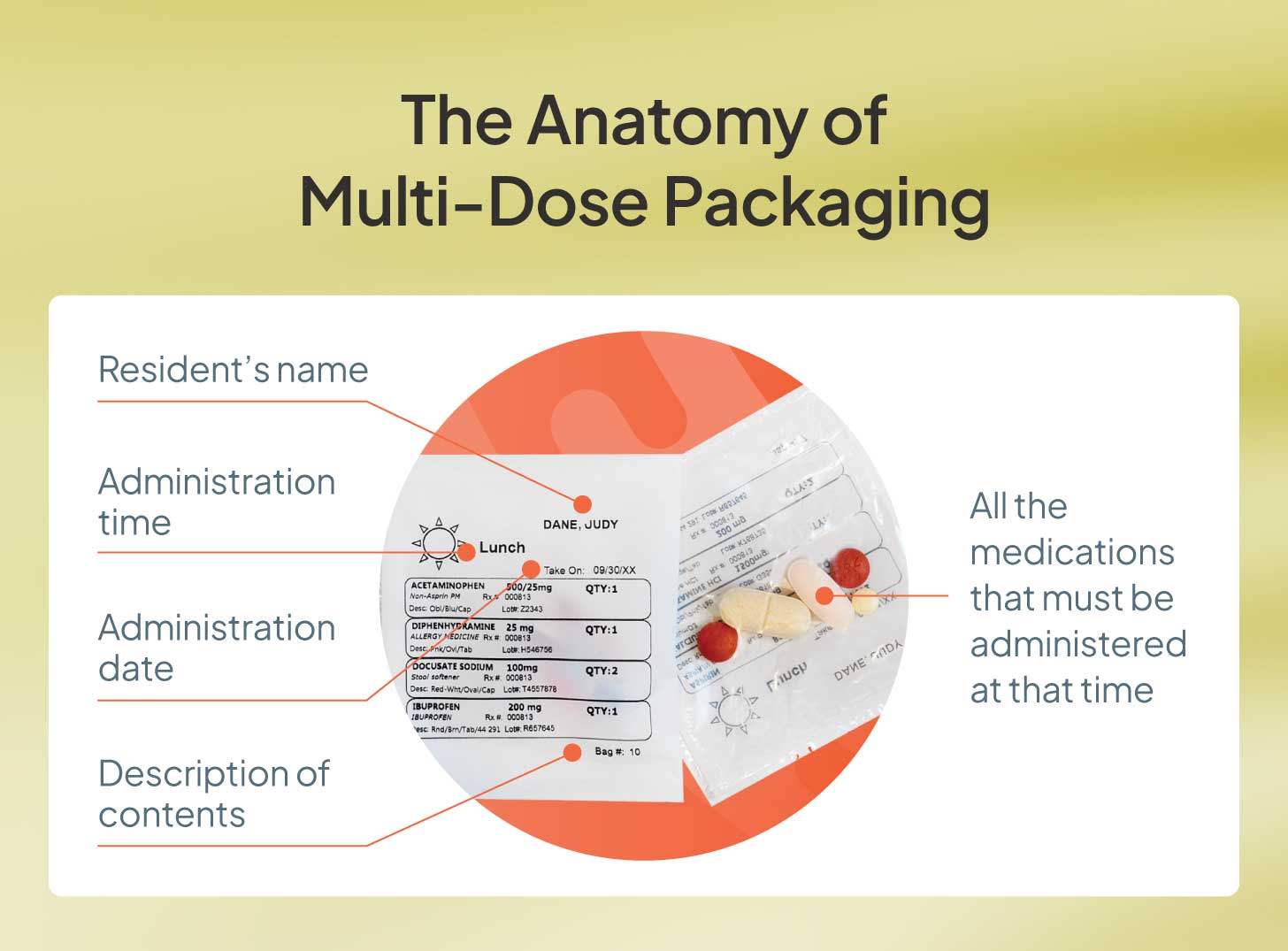A Closer Look at Unit Dose vs. Multi-Dose Packaging
Learn how unit dose and multi-dose packaging each support safe and effective medication distribution in senior living communities

Learn how unit dose and multi-dose packaging each support safe and effective medication distribution in senior living communities
Published on: July 25, 2025
Last updated: September 12, 2025

Contents
Medication administration is a complex and high-stakes responsibility in senior living communities. According to Merck, 43% of older adults take at least five prescription drugs regularly. For care teams, that means managing large volumes of medications with precision, where errors can have serious — even life-threatening — consequences.
Packaging plays a critical role in reducing those risks. Multi-dose packaging groups all of a resident’s scheduled medications into a single pouch or blister card for each administration time. Unit-dose packaging, however, separates each medication into its own individually sealed package.
Both approaches aim to support safer, more efficient medication workflows, and when paired with a strong eMAR system, they can help communities better manage risk, reduce waste, and improve staff confidence at the med cart.
In senior living, multi-dose packaging refers to the physical format used to organize and deliver a resident’s scheduled medications for a specific administration time.
The most common packaging format is pouches. These are individual, sealed pouches often dispensed on a continuous strip. Each pouch is clearly labeled with the resident’s name, along with the date, time, and contents, detailing each medication and its dosage.

To illustrate how multi-dose packaging works in a senior living environment, consider the following hypothetical example involving a resident named Rose.
Rose is an 80-year-old resident with multiple health conditions who takes several medications throughout the day. Her senior living community partners with a pharmacy that delivers medications pre-packaged in multi-dose strips. Each strip contains clearly labeled pouches, organized by date and time of administration.
Every small, sealed pouch includes:
For example, Rose’s 8 a.m. pouch contains:
During the morning medication pass, Sarah, a medication administrator, accesses the eMAR system and reviews Rose’s medication chart. She locates the correct pouch, scans the barcode, and confirms the match between the eMAR and the physical contents.
After verifying its accuracy, she hands the medication to Rose with a glass of water and records the administration in the eMAR. She then discards the empty pouch.
Later in the day, additional pouches for noon, evening, and bedtime are used in the same way, each containing the exact medications Rose needs at those times.
Disclaimer: This is a fictional scenario for illustrative purposes. Actual medication schedules and resident needs vary.
Multi-dose packaging offers several operational and clinical advantages for senior living communities. These benefits can improve both staff efficiency and resident outcomes.
With multi-dose packaging, care teams handle one pre-sorted pouch per administration time rather than managing multiple individual medications. Staff can quickly scan, verify, and administer the medication — all in a single step — reducing the time and complexity of each med pass.
Pre-packaged doses reduce the margin for error in medication selection and preparation. Medication administrators visually verify pouch contents against the eMAR. Scanning a single barcode confirms accuracy, helping ensure all five rights of medication administration: right resident, right drug, right dose, right route, and right time.
By consolidating medications into fewer packages per resident, multi-dose systems simplify ordering, receiving, and storage. Instead of reordering individual prescriptions piecemeal, communities work with the pharmacy to manage consistent multi-dose cycles. This reduces administrative burden, minimizes waste, and supports more accurate billing to improve revenue cycle management.
Multi-dose packaging promotes higher adherence by organizing medications by time and simplifying the process for both residents and caregivers. According to a STOMP study, 90% of patients using multi-dose blister cards maintained adherence after one year. When combined with an eMAR system that includes prompts and reminders, adherence improves even further.
Multi-dose packaging can generate savings across several areas: less medication waste, fewer administration errors, and reduced labor hours. In one study by Forum Pharmacy, three assisted living communities reduced medication pass time by 32% within 12 weeks of implementing multi-dose packaging with an eMAR system. One site saved 673 nursing hours per month, a substantial impact on staffing efficiency.
Unlike multi-dose packaging, where you package all of a resident’s medications for one specific administration time together, traditional unit dose packaging seals each dose in its own pouch or card.

Let’s return to Rose, our 80-year-old resident. In a community using unit-dose packaging, each of Rose’s medications, Lisinopril, calcium citrate, and aspirin, is packaged separately, either in individual blisters on a card or sealed pouches.
During the morning medication pass, Sarah reviews Rose’s chart in the eMAR system. She retrieves each dose for that time and scans the barcode on every package to confirm the medication, resident, and administration time.
After scanning, Sarah opens each package and visually verifies the medication against the eMAR’s image and details. Once confirmed, she gives the medications to Rose with a glass of water, and then records the administration in the eMAR system. This process is repeated for each scheduled dose throughout the day with every medication individually packaged, scanned, and verified before being administered.
Consider these benefits of utilizing unit dose packaging:
By packaging each dose individually rather than in bulk bottles unit-dose systems help reduce the risk of overdoses and support safer medication handling practices for both staff and residents.
Each unit is clearly labeled and tracked within the eMAR system. This reduces the chance of mistakes during selection and administration, streamlines verification, and supports the five rights of medication administration.
Unit-dose packaging is efficient and simple to hand out during med passes. Staff can focus on quick scanning and visual verification, saving time that can be redirected to resident care. Additionally, removing any discontinued medications is easy as the medpasser simply removes the entire card from the med cart.
Because doses are individually sealed, only what’s needed is dispensed, and unused medications can often be returned if unopened. One study from the University of Chicago estimated that long-term care communities waste up to $2 billion worth of medications annually, highlighting the cost-saving potential of unit-dose packaging.
Blister-style unit-dose packaging has been shown to support better adherence by simplifying the process. This is especially valuable for those managing chronic conditions or complex regimens.
Each unit dose includes clear labeling and can be scanned directly into the eMAR system. This enhances tracking across the medication lifecycle — from pharmacy to administration — and supports compliance and auditing processes.
Before transitioning to unit-dose or multi-dose packaging, it’s important to evaluate operational readiness and coordination across your systems and partners.
Not all eMAR systems or pharmacy providers support both unit-dose and multi-dose packaging. Before making a switch, confirm which barcode scanning and documentation features your current eMAR solution supports. Aline eMAR is one of the few senior living-specific platforms that accommodates both packaging types.
Most long-term care pharmacies offer unit-dose and multi-dose options, but successful implementation depends on strong collaboration. Your pharmacy partner should be equipped to guide the transition, ensure packaging compatibility, and offer continued support. Establish clear communication protocols between your care team, pharmacy, and technology providers to avoid disruptions and ensure a smooth, coordinated rollout.
Medication regimens in senior living are rarely one-size-fits-all. Residents often have unique schedules, unconventional dosing times, and frequent prescription changes, making flexibility essential.
Experienced pharmacy partners are well-equipped to accommodate these complexities. Working closely with your community’s physicians and nursing staff, they can tailor packaging to meet individual needs through solutions such as:
Customizable packaging helps ensure each resident receives the right medication at the right time, even as needs evolve.
Introducing a new medication management system to your community involves an initial setup process and time for staff training. However, the long-term efficiencies gained with unit-dose or multi-dose packaging outweigh these.
Reputable pharmacy partners and your eMAR provider should offer comprehensive training programs and ongoing support to ensure a smooth transition for your team.
Implementing unit-dose or multi-dose packaging may require upfront investment—whether through upgrading to an eMAR system that supports barcode scanning or accommodating potential packaging fees from your pharmacy provider.
Before making the transition, conduct a detailed cost-benefit analysis. Consider factors such as time savings, reduced medication errors, improved inventory management, and decreased waste. When paired with a robust eMAR system, these efficiencies can offset initial costs and deliver long-term operational and financial benefits.
To help clarify common questions about unit-dose and multi-dose packaging, here are answers to a few frequently asked questions:
The process may vary depending on your pharmacy partner, but here’s how it typically works.
When a resident’s prescription is updated by their physician, the pharmacy will be notified and will update their system. This will automatically update the same information in eMAR. The pharmacy then prepares a revised multi-dose cycle reflecting the changes and ships it promptly to your community.
As for unused doses, some pharmacies allow returns of unopened, non-controlled medications for credit or proper disposal. Others may require your community to dispose of them in accordance with federal, state, and local regulations. Be sure to confirm your pharmacy’s return and disposal policies in advance.
Yes, implementing multi-dose or unit-dose packaging typically involves some associated costs, similar to any specialized medication packaging system. These may include:
While these upfront costs can vary, many communities find that the long-term savings in efficiency, error reduction, and medication waste can help offset the initial investment.
While multi-dose packaging offers many benefits, there are a few potential challenges to consider.
While unit-dose packaging supports safety and accuracy, consider a potential disadvantage:
A thorough assessment of your community’s needs along with strong pharmacy collaboration and a well-executed implementation plan can help mitigate these challenges and ensure a successful rollout.
Multi-dose and unit-dose packaging offer clear advantages over traditional pill bottle systems—especially when paired with a senior living-specific eMAR like Aline eMAR. Together, they help reduce errors, save time, and improve medication workflows across your community.
Ready to simplify your med pass process? Let’s start a conversation today about how Aline eMAR, combined with smart packaging solutions, can support safer, more efficient care.

Amanda McGrory-Dixon
Amanda McGrory-Dixon is the content marketing manager at Aline, where she shares expert insights on how senior living communities can streamline operations, enhance resident satisfaction, and drive sustainable growth. With a deep understanding of industry trends and technology, she helps operators navigate challenges and implement data-driven strategies to improve efficiency, profitability, and care outcomes.
Blogs, stories and studies from the forefront of senior living operations

Lead generation surveys give senior living operators the data they need to understand their market, uncover new opportunities, and drive occupancy growth.

Prospect-centered selling helps senior living operators convert more leads and achieve occupancy goals through a more personalized, empathetic approach.

Gain insight into senior living pricing strategies for community success. Explore how Aline’s software optimizes revenue and operations

Overcome the biggest senior living financial challenges, including operational costs and occupancy rates, with interconnected software

Take a look at how senior living software options, like Aline, can elevate operations, resident care, and ROI

Enhance efficiency, accuracy, and resident satisfaction by integrating a POS system into your senior living dining operations
We’re using cookies on this site to improve your experience. Cookies help us learn how you interact with our website, and remember you when you come back so we can tailor it to your interests.
You can find out more about cookies and usage on our cookie policy page.
Some of these cookies are essential, while others help us to improve your experience by providing insights into how the site is being used.
For more detailed information on the cookies we use, please check our privacy policy
Your experience is important to us. We’re redirecting you to our new Aline website, where you’ll discover how our complete suite of senior living solutions can help you grow occupancy and revenue, optimize operations, and enhance resident care.
For more information, you’re welcome to read our statement on our merger. To continue your web experience, simply close this notification.
Your experience is important to us. We’re redirecting you to our new Aline website, where you’ll discover how our complete suite of senior living solutions can help you grow occupancy and revenue, optimize operations, and enhance resident care.
For more information, you’re welcome to read our statement on our merger. To continue your web experience, simply close this notification.
Your experience is important to us. We’re redirecting you to our new Aline website, where you’ll discover how our complete suite of senior living solutions can help you grow occupancy and revenue, optimize operations, and enhance resident care.
For more information, you’re welcome to read our statement on our merger. To continue your web experience, simply close this notification.
Your experience is important to us. We’re redirecting you to our new Aline website, where you’ll discover how our complete suite of senior living solutions can help you grow occupancy and revenue, optimize operations, and enhance resident care.
For more information, you’re welcome to read our statement on our merger. To continue your web experience, simply close this notification.